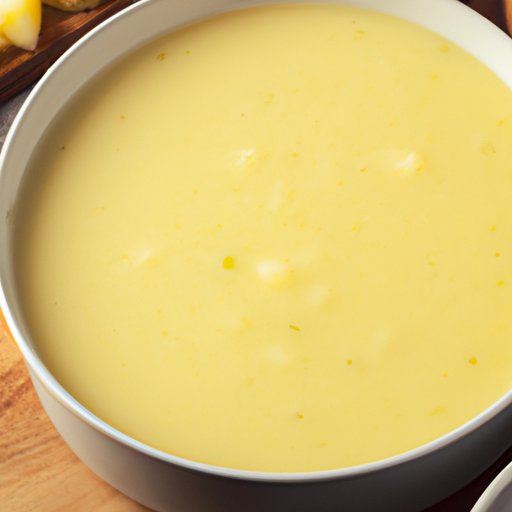
I. Introduction
If you’ve ever made potato soup, you may have experienced the frustration of it being too thin or watery in texture. This common problem can put a damper on an otherwise perfect soup, but fear not! In this article, we will explore several different methods to thicken potato soup, ensuring it’s the perfect consistency every time.
II. Adding Cream or Milk
One of the most straightforward ways to thicken potato soup is to add heavy cream or milk. Not only does this method add richness and flavor to the soup, but it also helps to thicken it.
When adding cream or milk to your soup, it’s important to do so slowly and in small increments while continuously stirring. This allows the cream or milk to incorporate thoroughly and prevents curdling. Be sure not to boil the soup after adding the dairy, as this can also lead to curdling.
Although adding cream or milk is a popular method, it’s worth considering the potential drawbacks. Dairy can cause the soup to become too heavy or even overpower the flavor of other ingredients in the soup.
III. Thickening with Flour
Another common method of thickening soup is by using flour. To use this method, you’ll need to mix a small amount of flour with cold water until it becomes a paste. Mix the paste into the soup slowly and in small increments while stirring continuously until the soup reaches the desired texture.
The recommended amount of flour to add varies depending on the quantity of soup you’re making. Start with a tablespoon of flour per cup of soup and incrementally add more as needed. Keep in mind that using too much flour can lead to a gluey texture in the soup.
Precautions to take when using flour include ensuring it’s evenly mixed, not adding it directly to the soup, and not letting the soup boil after adding flour.
IV. Using Cornstarch
Cornstarch is a gluten-free alternative to flour and is another method to thicken potato soup. To use this method, start by mixing cornstarch with cold water to create a slurry. A ratio of one tablespoon of cornstarch to one cup of soup is generally recommended.
Before adding the cornstarch slurry to the soup, make sure the soup is hot and has reached a boiling point, then slowly pour the cornstarch slurry into the soup while continuously stirring. Continue to stir the soup until it reaches your desired thickness.
It’s important not to let the soup boil after adding cornstarch. Doing so can cause the soup to thin out again and even become lumpy or gritty.
V. Adding Pureed Vegetables
Using pureed vegetables is another option for thickening potato soup. Not only is it a healthy alternative, but it also adds more nutritional value and flavor to the soup.
When choosing vegetables to add, consider options like carrots, celery, or leeks. To prepare, cook the vegetables first until tender, then puree them in a blender or food processor. Slowly add the pureed vegetables to your soup while continuously stirring until it reaches your desired thickness.
To avoid clumps or chunks of vegetables in your soup, it’s important to ensure the puree is smooth and free of any lumps before adding it to the soup.
VI. Mashing Potatoes
One of the simplest methods to thicken potato soup is by mashing some of the potatoes themselves. This method is best used if you’ve already cut potatoes into small pieces before cooking.
To use this method, use a fork or potato masher to mash some of the cooked potatoes until they are smooth. Then, slowly add them back into the soup while stirring continuously until it reaches your desired thickness.
Be mindful of how much you mash the potatoes. Too much mashing can lead to a puree-like soup that’s overly thick and not very appetizing.
VII. Letting it Simmer
Letting potato soup simmer is another way to thicken it. When simmering, it’s essential to use medium-low heat and stir frequently to prevent burning or sticking. When you simmer, the soup will reduce and thicken naturally over time.
How long to let the soup simmer depends on how thick you want the soup to become. Some recipes may take as little as 20 minutes, while others may need an hour or more to thicken to the desired consistency. Be sure to adjust the seasoning towards the end of the cooking process as the soup will become more concentrated in flavor as it thickens.
VIII. Conclusion
In conclusion, there are many different methods to choose from when it comes to thickening potato soup. Whether you opt for heavy cream, flour, cornstarch, pureed vegetables, mashing potatoes, or simmering, be sure to consider the advantages and disadvantages of each method.




